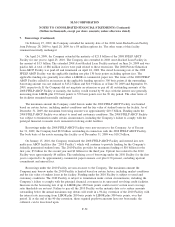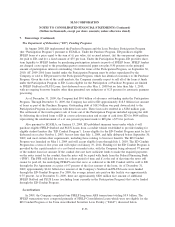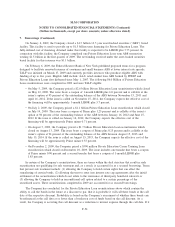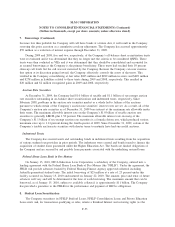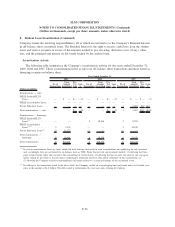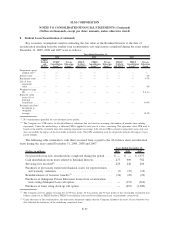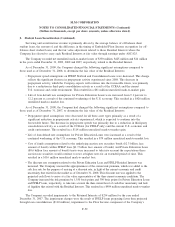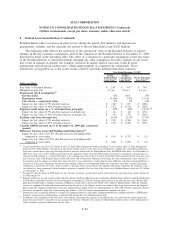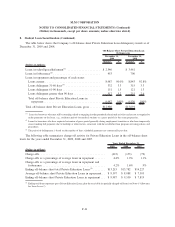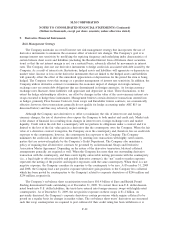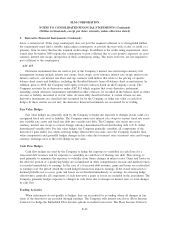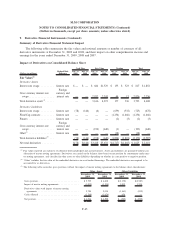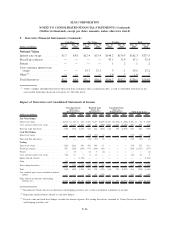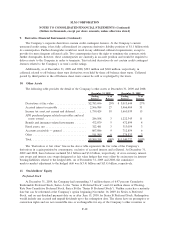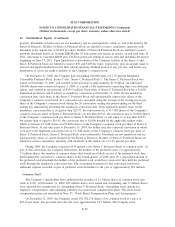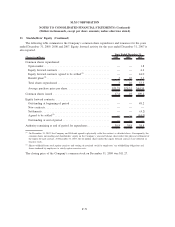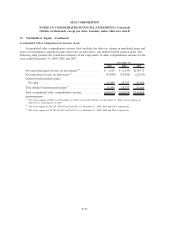Sallie Mae 2009 Annual Report Download - page 189
Download and view the complete annual report
Please find page 189 of the 2009 Sallie Mae annual report below. You can navigate through the pages in the report by either clicking on the pages listed below, or by using the keyword search tool below to find specific information within the annual report.9. Derivative Financial Instruments
Risk Management Strategy
The Company maintains an overall interest rate risk management strategy that incorporates the use of
derivative instruments to minimize the economic effect of interest rate changes. The Company’s goal is to
manage interest rate sensitivity by modifying the repricing frequency and underlying index characteristics of
certain balance sheet assets and liabilities (including the Residual Interest from off-balance sheet securitiza-
tions) so that the net interest margin is not, on a material basis, adversely affected by movements in interest
rates. The Company does not use derivative instruments to hedge credit risk associated with debt issued by the
Company. As a result of interest rate fluctuations, hedged assets and liabilities will appreciate or depreciate in
market value. Income or loss on the derivative instruments that are linked to the hedged assets and liabilities
will generally offset the effect of this unrealized appreciation or depreciation for the period the item is being
hedged. The Company views this strategy as a prudent management of interest rate sensitivity. In addition, the
Company utilizes derivative contracts to minimize the economic impact of changes in foreign currency
exchange rates on certain debt obligations that are denominated in foreign currencies. As foreign currency
exchange rates fluctuate, these liabilities will appreciate and depreciate in value. These fluctuations, to the
extent the hedge relationship is effective, are offset by changes in the value of the cross-currency interest rate
swaps executed to hedge these instruments. Management believes certain derivative transactions entered into
as hedges, primarily Floor Income Contracts, basis swaps and Eurodollar futures contracts, are economically
effective; however, those transactions generally do not qualify for hedge accounting under ASC 815 (as
discussed below) and thus may adversely impact earnings.
Although the Company uses derivatives to offset (or minimize) the risk of interest rate and foreign
currency changes, the use of derivatives does expose the Company to both market and credit risk. Market risk
is the chance of financial loss resulting from changes in interest rates, foreign exchange rates and market
liquidity. Credit risk is the risk that a counterparty will not perform its obligations under a contract and it is
limited to the loss of the fair value gain in a derivative that the counterparty owes the Company. When the fair
value of a derivative contract is negative, the Company owes the counterparty and, therefore, has no credit risk
exposure to the counterparty; however, the counterparty has exposure to the Company. The Company
minimizes the credit risk in derivative instruments by entering into transactions with highly rated counter-
parties that are reviewed regularly by the Company’s Credit Department. The Company also maintains a
policy of requiring that all derivative contracts be governed by an International Swaps and Derivative
Association Master Agreement. Depending on the nature of the derivative transaction, bilateral collateral
arrangements generally are required as well. When the Company has more than one outstanding derivative
transaction with the counterparty, and there exists legally enforceable netting provisions with the counterparty
(i.e., a legal right to offset receivable and payable derivative contracts), the “net” mark-to-market exposure
represents the netting of the positive and negative exposures with the same counterparty. When there is a net
negative exposure, the Company considers its exposure to the counterparty to be zero. At December 31, 2009
and 2008, the Company had a net positive exposure (derivative gain positions to the Company less collateral
which has been posted by counterparties to the Company) related to corporate derivatives of $246 million and
$234 million, respectively.
The Company’s on-balance sheet securitization trusts have $10.4 billion of Euro and British Pound
Sterling denominated bonds outstanding as of December 31, 2009. To convert these non-U.S. dollar denomi-
nated bonds into U.S. dollar liabilities, the trusts have entered into foreign-currency swaps with highly-rated
counterparties. As of December 31, 2009, the net positive exposure on these swaps is $1.2 billion. As
previously discussed, the Company’s corporate derivatives contain provisions which require collateral to be
posted on a regular basis for changes in market values. The on-balance sheet trusts’ derivatives are structured
such that swap counterparties are required to post collateral if their credit rating has been withdrawn or is
F-62
SLM CORPORATION
NOTES TO CONSOLIDATED FINANCIAL STATEMENTS (Continued)
(Dollars in thousands, except per share amounts, unless otherwise stated)


